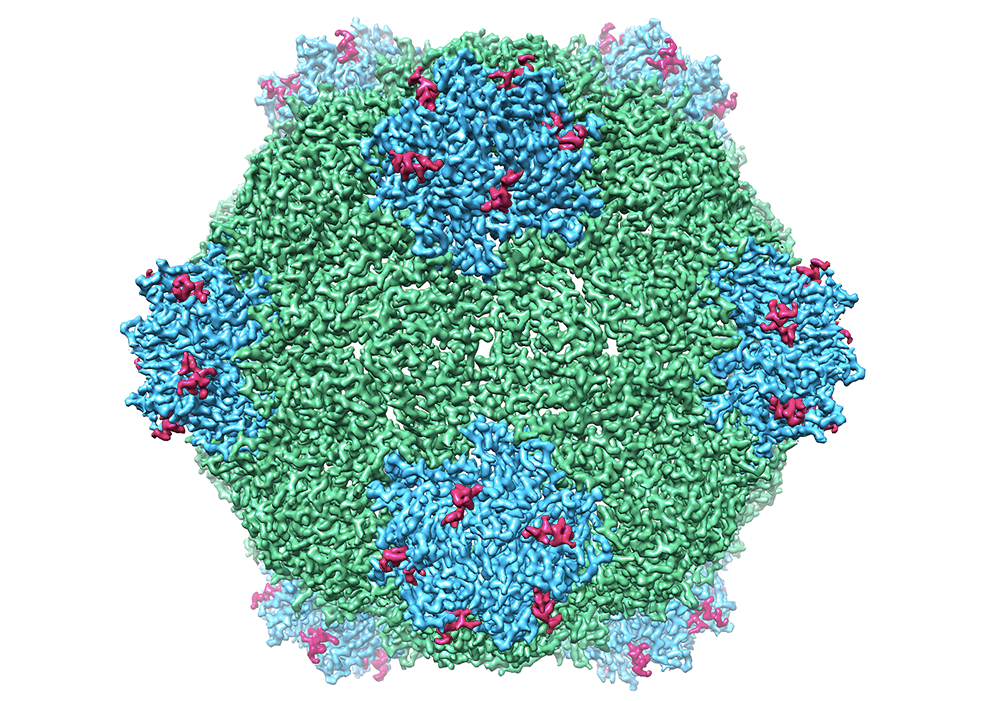
Scientists have refined the structure of a tiny plant virus, and a related non-infectious virus-like particle, as part of a collaborative research project at the John Innes Centre and the University of Leeds.
Cowpea mosaic virus (CPMV) is an infectious particle that can replicate to produce many billions of copies of itself in plants.
The virus is made up of a hollow sphere of protein, called a capsid, which is in turn made up of jigsaw pieces called ‘S’ and ‘L’ subunits. Inside this protein sphere is the virus’s RNA genome, which contains the instructions to make more virus particles.
In previous award-winning research, Professor George Lomonossoff and colleagues from the Department of Biological Chemistry developed a system to create ‘empty virus-like particles’ (eVLPs) – essentially, the CPMV capsid, without the infectious RNA inside. Instead of delivering the virus genome they can be used as a vehicle for targeted drug delivery, a source of novel diagnostic reagents or even new vaccines.
Although research in this area is promising, we do not know very much about how the structure of CPMV and eVLPs relates to their function.
A question Professor Lomonossoff and his colleagues at JIC and in Leeds particularly wanted to answer was: when a new virus particle assembles itself, how do the pieces stick together, and how does the RNA get inside the capsid? Knowing this information would help the team to engineer non-infectious eVLPs with RNA that, instead of producing proteins that make plants sick, would create useful products such as vaccines, drugs, or industrial chemicals.
Viruses are so tiny that they cannot be seen with the naked eye, or even with a normal light microscope, so most of what we know about them comes from experimental evidence supporting predictions made by computer models, or by X-ray crystallographic studies.
In a new study published in Nature Communications, Professor Lomonossoff and his colleagues at JIC, in collaboration with the group led by Dr Neil Ranson at the University of Leeds, used a special high-resolution cryo electron microscope, which can distinguish between structures approximately 3–3.5 Ångstroms (3 Å) apart (there are 10 million Ångstroms to 1 mm!), to visualise the structure of the capsid.
The JIC team had predicted that a tiny extension on the S subunits of the capsid was involved in helping to ‘encapsidate’ RNA during virus assembly. There was just one problem: no-one had ever seen this extension because it is thought to be ‘snipped off’ when the virus matures.
The cryo electron microscope studies by the Leeds Group were able to reveal the structure of this region for the first time, leading to a prediction of how it works.
Professor Lomonossoff said: “The structural studies show that the extension acts like a dab of ‘molecular glue’ to stabilise the capsid subunits as they are pieced together. Thanks to these wonderful new images, we’ve now seen with our own eyes how the extension works, both in the infectious cowpea mosaic virus, and in our empty virus-like particle. This is a very important finding to validate our work on eVLPs – we now know that our engineered capsids are put together in the same way as CPMV, and as a result we now have a new model for virus assembly.
Because CPMV is a member of a large family of viruses that includes polio, foot-and-mouth and Hepatitis A, our studies should also aid our understanding of how these important animal viruses assemble.”
